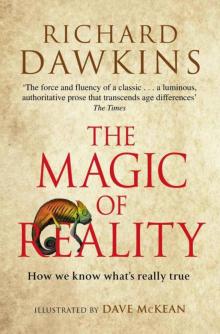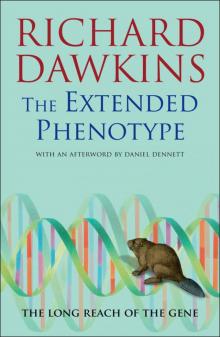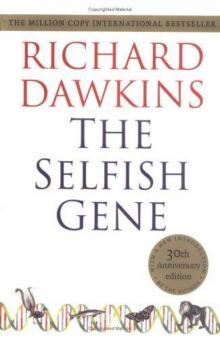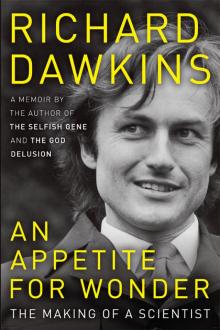- Home
- Richard Dawkins
The Greatest Show on Earth Page 24
The Greatest Show on Earth Read online
Page 24
The living cell, too, is a great chemistry lab, and it has a similarly large store of chemicals. But they aren’t kept in separate bottles and jars on shelves. They are all mixed up together. It is as though a vandal, a chemical lord of misrule, entered the lab, seized all the bottles on all the shelves, and tipped them with anarchistic abandon into one great cauldron. Terrible thing to do? Well, it would be if they all reacted together, in all possible combinations. But they don’t. Or if they do, the rate at which they react together is so slow that they might as well not be reacting at all. Except – and this is the whole point – if an enzyme is present. There is no need for glass bottles and jars to keep the substances apart because, to all intents and purposes, they are not going to react together anyway – unless the right enzyme is present. The equivalent of keeping the chemicals in stoppered bottles until you want to mix a particular pair, say A and B, is to mix all the hundreds of substances up in a great witch’s brew, but supply only the right enzyme to catalyse the reaction between A and B and no other combination. Actually, the metaphor of the anarchically inclined bottle-tipper goes too far. Cells do contain an infrastructure of membranes between which, and within which, chemical reactions go on. To some extent, these membranes play the role of glass partitions between test tubes and flasks.
The point of this section of the chapter is that ‘the right enzyme’ achieves its ‘rightness’ largely through its physical shape (and that’s important, because the physical shape is determined by genes, and it is genes whose variations are ultimately favoured or disfavoured by natural selection). Molecules aplenty are drifting and twisting and spinning through the soup that bathes the interior of a cell. A molecule of substance A might be happy to react with a molecule of substance B, but only if they happen to collide when facing in exactly the right direction, relative to each other. Crucially, that seldom happens – unless the right enzyme intervenes. The enzyme’s precise shape, the shape into which it folded itself like a magnetic necklace, leaves it pitted with cavities and dents, each one of which itself has a precise shape. Each enzyme has a so-called ‘active site’, which is usually a particular dent or pocket, whose shape and chemical properties confer upon the enzyme its specificity. The word ‘dent’ doesn’t adequately convey the specificity, the precision, of this mechanism. Perhaps a better comparison is with an electric socket. In what my friend the zoologist John Krebs calls ‘the great plug conspiracy’, different countries around the world have irritatingly adopted different arbitrary conventions for plugs and sockets. British plugs won’t fit American sockets, or French sockets, and so on. The active sites on the surface of protein molecules are sockets into which only certain molecules will fit. But whereas the great plug conspiracy runs to only half a dozen separate shapes around the world (quite enough to constitute a continual annoyance to the traveller), the different kinds of sockets sported by enzymes are far more numerous.
Think of a particular enzyme, which catalyses the chemical combination of two molecules, P and Q, to make the compound PQ. One half of the active site ‘socket’ is just right for a molecule of type P to nestle into, like a jigsaw piece. The other half of the same socket is equally precisely shaped for a Q molecule to slot in – facing exactly the right way to combine chemically with the P molecule that is already there. Sharing a dent, firmly held at just the right angle to each other by the matchmaking enzyme molecule, P and Q unite. The new compound, PQ, now breaks away into the soup, leaving the active dent in the enzyme molecule free to bring together another P and another Q. A cell may be filled with swarms of identical enzyme molecules, all working away like robots in a car factory, churning out PQ in the cellular equivalent of industrial quantities. Put a different enzyme into the same cell, and it will churn out a different product, perhaps PR, or QS or YZ. The end product is different, even though the available raw materials are the same. Other types of enzymes are concerned not with constructing new compounds, but with breaking down old ones. Some of these enzymes are involved in digesting food, and they are exploited, too, in ‘biological’ washing powders. But, since this chapter is about the construction of embryos, we are here mostly concerned with constructive enzymes, which broker the synthesis of new chemical compounds. One such process is shown in action on colour page 12.
A problem may have occurred to you. It’s all very well to talk of jigsaw dents and sockets, highly specific active sites capable of speeding up a particular chemical reaction a trillionfold. But doesn’t it sound too good to be true? How do enzyme molecules of exactly the right shape evolve from less perfect beginnings? What is the probability that a socket, shaped at random, will have just the right shape, and just the right chemical properties, to arrange a marriage between two molecules, P and Q, finessing their encounter at exactly the right angle? Not very great if you think ‘finished jigsaw’ – or, indeed, if you think ‘great plug conspiracy’. Instead, you have to think ‘smooth gradient of improvement’. As so often when we are faced with the riddle of how complex and improbable things can arise in evolution, it is a fallacy to assume that the final perfection that we see today is the way it always was. Fully fashioned, highly evolved enzyme molecules achieve trillionfold speedups of the reactions they catalyse, and they do so by being beautifully crafted to exactly the right shape. But you don’t need a trillionfold speedup in order to be favoured by natural selection. A millionfold will do nicely! So will a thousandfold. And even tenfold or twofold would be enough for natural selection to get an adequate grip. There is a smooth gradient of improvement in an enzyme’s performance, all the way from almost no dent at all, through a crudely shaped dent, to a socket of exactly the right shape and chemical signature. ‘Gradient’ means that each step is a noticeable improvement, however slight, over the one before. And ‘noticeable’ for natural selection can mean an improvement smaller than the minimum that would be required for us to notice it.
So, you see the way it works. Elegant! A cell is a versatile chemical factory, capable of spewing out massive quantities of a wide variety of different substances, the choice being made by which enzyme is present. And how is that choice made? By which gene is turned on. Just as the cell is a vat filled with lots of chemicals, only a minority of which react with each other, so every cell nucleus contains the entire genome, but with only a minority of genes turned on. When a gene is turned on in, say, a cell of the pancreas, its sequence of code letters directly determines the sequence of amino acids in a protein; and the sequence of amino acids determines (remember the image of the magnetic necklace?) the shape into which the protein folds itself; and the shape into which the protein folds itself determines the precisely shaped sockets that marry up substances drifting around in the cell. Every cell, with very few exceptions such as red blood corpuscles, which lack a nucleus, contains the genes for making all the enzymes. But in any one cell, only a few genes will be turned on at any one time. In, say, thyroid cells, the genes that make the right enzymes for catalysing the manufacture of thyroid hormone are turned on. And correspondingly for all the different kinds of cells. Finally, the chemical reactions that go on in a cell determine the way that cell is shaped and the way it behaves, and the way it participates in origami-style interactions with other cells. So the whole course of embryonic development is controlled, via an intricate sequence of events, by genes. It is genes which determine sequences of amino acids, which determine tertiary structures of proteins, which determine the socket-like shapes of active sites, which determine cell chemistry, which determine ‘starling-like’ cell behaviour in embryonic development. So, differences in genes can, at the originating end of the complex chain of events, cause differences in the way embryos develop, and hence differences in the form and behaviour of adults. The survival and reproductive success of those adults then feeds back on the survival in the gene pool of the genes that made the difference between success and failure. And that is natural selection.
Cellular family tree of Caenorhabditis elegans
Embryolo
gy seems complicated – is complicated – but it is easy to grasp the important point, which is that we are dealing with local self-assembly processes all the way. It’s a separate question, given that (almost) all the cells contain all the genes, how it is decided which genes are turned on in each different kind of cell. I must briefly deal with that now.
THEN WORMS SHALL TRY
Whether or not a given gene is turned on in a given cell at a given time is determined, often via a cascade of other genes called switch genes or controller genes, by the chemical environment of the cell. Thyroid cells are quite different from muscle cells, and so on, even though their genes are the same. That’s all very well, you may say, once the development of the embryo is under way, and the different kinds of tissues such as thyroid and muscle already exist. But every embryo starts out as a single cell. Thyroid cells and muscle cells, liver cells and bone cells, pancreas cells and skin cells, all are descended from a single fertilized egg cell, via a branching family tree. This is a cellular family tree going back no further than the moment of conception, nothing to do with the evolutionary tree going back millions of years, which keeps cropping up in other chapters. Let me show you, for example, the complete family tree of all 558 cells of a newly hatched larva of the nematode worm, Caenorhabditis elegans (below: please pay close attention to every detail of this diagram). By the way, I don’t know what this tiny worm did to earn its species name of elegans, but I can think of a good reason why it might have deserved it retrospectively. I know that not all my readers like my digressions, but the research that has been done on Caenorhabditis elegans is such a ringing triumph of science that you aren’t going to stop me.
Caenorhabditis elegans was chosen in the 1960s as an ideal experimental animal by the formidably brilliant South African biologist Sydney Brenner. He had recently completed his work, with Francis Crick and others at Cambridge, on cracking the genetic code, and was looking around for a new big problem to solve. His inspired choice, and his own pioneering research on its genetics and neuro-anatomy, has led to a worldwide community of Caenorhabditis researchers that has grown into the thousands. It is only a bit of an exaggeration to say that we now know everything about Caenorhabditis elegans! We know its entire genome. We know exactly where every one of its 558 cells (in the larva; 959 in the adult hermaphroditic form, not counting reproductive cells) is in the body, and we know the exact ‘family history’ of every one of those cells, through embryonic development. We know of a large number of mutant genes, which produce abnormal worms, and we know exactly where the mutation acts in the body and the exact cellular history of how the abnormality develops. This little animal is known from start to finish, known inside out, known from head to tail and all stations in between, known through and through (‘O frabjous day!’). Brenner was belatedly recognized with the Nobel Prize for Physiology in 2002, and a related species was named in his honour, Caenorhabditis brenneri. His regular column in the journal Current Biology, under the byline ‘Uncle Syd’, is a model of intelligent and irreverent scientific wit – as elegant as the worldwide research effort on C. elegans that he inspired. But I do wish molecular biologists would talk to some zoologists (like Brenner himself) and learn not to refer to Caenorhabditis as ‘the’ nematode, or even ‘the’ worm, as though there were no others.
Of course you can’t read the names of the cell types at the bottom of the diagram (it would take seven pages to print the whole thing out legibly), but they say things like ‘pharynx’, ‘intestinal muscle’, ‘body muscle’, ‘sphincter muscle’, ‘ring ganglion’, ‘lumbar ganglion’. The cells of all these types are literally cousins of one another: cousins by virtue of their ancestry within the lifetime of the individual worm. For example, I am looking at a particular body muscle cell called MSpappppa, which is a sibling of another body muscle cell, first cousin of two more body muscle cells, first cousin once removed of two more body muscle cells, second cousin of six pharynx cells, third cousin of seventeen pharynx cells . . . and so on. Isn’t it amazing that we can actually use words like ‘second cousin once removed’, with the utmost precision and certainty, to refer to named and repeatably identifiable cells in an animal’s body? The number of cell ‘generations’ that separates the tissues from the original egg is not that great. After all, there are only 558 cells in the body, and you can theoretically make 1,024 (2 to the power 10) in ten generations of cell splitting. The numbers of cell generations for human cells would be much larger. Nevertheless, you could in theory make a similar family tree for every one of your trillion-odd cells (as opposed to the 558 cells of a C. elegans female larva), tracing each one’s descent back to the one fertilized egg cell. In mammals, however, it is not possible to identify particular, repeatably named cells. In us, it is more a case of statistical populations of cells, whose details are different in different people.
I hope my euphoric digression on the elegance of Caenorhabditis research has not distracted us too far from the point I was making about how cell types change in their shape and character as they branch away from one another in the embryonic family tree. At the branching point between a clone that is destined to become pharynx cells, and a ‘cousin’ clone that is destined to become ring ganglion cells, there has to be something to distinguish them, otherwise how would they know to turn on different genes? The answer is that, when the most recent common ancestor of the two clones divided, the two halves of the cell before division were different. So, when the cell divided, the two daughter cells, though identical in their genes (every daughter cell receives a full complement of genes), were not identical in the surrounding chemicals. And this meant that the same genes were not turned on – which changed the fate of their descendants. The same principle applies right through embryology, including its very start. The key to differentiation, in all animals, is asymmetric cell division.*
Sir John Sulston and his colleagues traced each of the cells in the body of the worm back to one and only one of six founder cells – we might even call them ‘matriarch’ cells – called AB, MS, E, D, C and P4. †In naming the cells, they used a neat notation that summarized the history of each one. Every cell’s name begins with the name of one of those six founder cells, the one from which it is descended. Thereafter, its name is a string of letters, the initial letters of the direction of cell division that gave rise to it: anterior, posterior, dorsal, ventral, left, right. For example, Ca and Cp are the two daughters of matriarch C, the anterior and posterior daughter respectively. Notice that every cell has no more than two daughters (of which one may die). I am now looking at a particular body muscle cell, whose name, Cappppv, succinctly discloses its history: C had an anterior daughter, which had a posterior daughter, which had a posterior daughter, which had a posterior daughter, which had a posterior daughter, which had a ventral daughter, which is the body muscle cell in question. Every cell in the body is denoted by a comparable string of letters headed by one of the six founder cells. ABprpapppap, to take another example, is a nerve cell that sits in the ventral nerve cord running along the length of the worm. Needless to say, it is not necessary to take in the details. The beautiful point is that every single cell in the body has such a name, which totally describes its history during embryology. Every one of the ten cell divisions that gave rise to ABprpapppap, and every other cell, was an asymmetric division with the potential for different genes to be switched on in each of the two daughter cells. And in all animals that is the principle by which tissues differentiate, even though all their cells contain the same genes. Most animals, of course, have far more cells than Caenorhabditis’ 558, and their embryonic development is in most cases less rigidly determined. In particular, as Sir John Sulston kindly reminds me, and as I have already briefly mentioned, in a mammal the ‘family trees’ of our cells are different for every individual, whereas in Caenorhabditis they are almost identical (except in mutant individuals). Nevertheless, the principle remains the same. In any animal, cells differ from each other in different parts of the bo
dy, even though they are genetically identical, because of their history of asymmetric cell division during the short course of embryonic development.
Let us hear the conclusion of the whole matter. There is no overall plan of development, no blueprint, no architect’s plan, no architect. The development of the embryo, and ultimately of the adult, is achieved by local rules implemented by cells, interacting with other cells on a local basis. What goes on inside cells, similarly, is governed by local rules that apply to molecules, especially protein molecules, within the cells and in the cell membranes, interacting with other such molecules. Again, the rules are all local, local, local. Nobody, reading the sequence of letters in the DNA of a fertilized egg, could predict the shape of the animal it is going to grow into. The only way to discover that is to grow the egg, in the natural way, and see what it turns into. No electronic computer could work it out, unless it was programmed to simulate the natural biological process itself, in which case you might as well dispense with the electronic version and use the developing embryo as its own computer. This way of generating large and complex structures purely by the execution of local rules is deeply distinct from the blueprint way of doing things. If the DNA were some kind of linearized blueprint, it would be a relatively trivial exercise to program a computer to read the letters and draw the animal. But it would not be at all easy – indeed, it might be impossible – for the animal to have evolved in the first place.
And now, so that this chapter on embryos should not end up as a mere digression in a book on evolution, I must return to the sincere dilemma of Haldane’s questioner. Given that genes control processes of embryonic development rather than adult shape; given that natural selection – like God – doesn’t build tiny wings, but embryology does; how does natural selection go to work on animals to shape their bodies and their behaviour? How does natural selection go to work on embryos, in other words, to rejig them so they become ever more proficient at building successful bodies, with wings, or fins, leaves or armour plating, stings or tentacles or whatever it takes to survive?

 The Magic of Reality
The Magic of Reality The Extended Phenotype
The Extended Phenotype The God Delusion
The God Delusion The Selfish Gene
The Selfish Gene The Blind Watchmaker
The Blind Watchmaker The Greatest Show on Earth
The Greatest Show on Earth Climbing Mount Improbable
Climbing Mount Improbable Outgrowing God
Outgrowing God Brief Candle in the Dark
Brief Candle in the Dark The Greatest Show on Earth: The Evidence for Evolution
The Greatest Show on Earth: The Evidence for Evolution Science in the Soul
Science in the Soul An Appetite for Wonder
An Appetite for Wonder